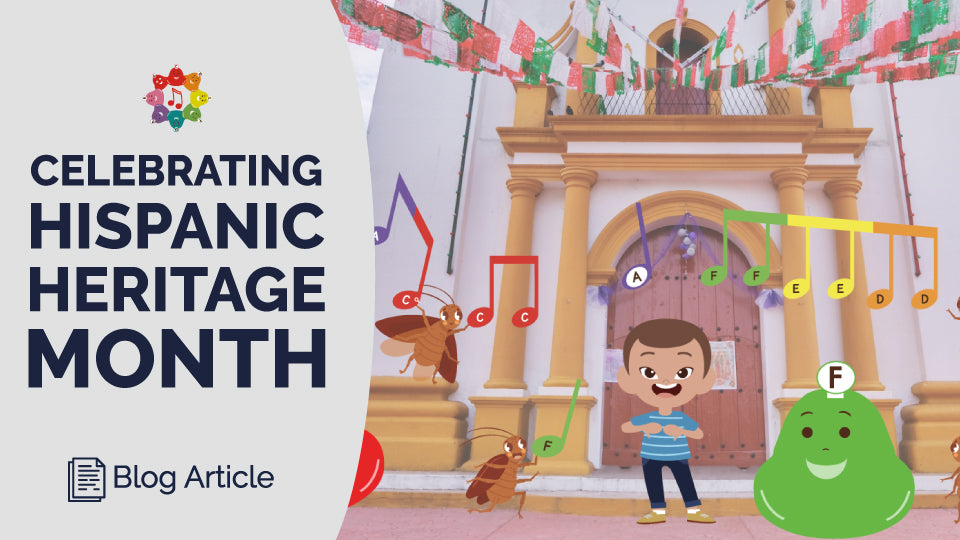Hispanic Heritage Month pays tribute to generations of Hispanic Americans and their positive influence on culture and society. It’s also an opportunity to trace back the global roots and recognize some artists that helped shape our world of music.
Buenos Días
Buenos Días is the first Prodigies video to feature a Spanish language song! This popular classroom classic makes a great welcome song. In this version, we focus on keeping a steady beat by clapping, tapping and stomping!
Lyrics:
Buenos Días (Good morning) ¿Cómo estás? (How are you?) Muy Bien (Very well)
Gracias (Thank you)
¿Y Usted? (And you?)
Los Pollitos Dicen
Los Pollitos Dicen or “The Little Chicks Say” is a classic Spanish Nursery Rhyme whose popularity is similar to that of “Twinkle Twinkle Little Star” in English. It’s sung in the households of many Spanish speaking countries from Mexico to Ecuador and Spain but its author is Chilean teacher, poet and musician Ismael Parraguez. Parraguez was prolific in his short life, writing books, hymns and children’s songs that have been absorbed intro a global culture and celebrated more than 100 years later.
The lyrics of Los Pollitos Dicen feature an onomatopoeia, a word formed from a sound. The little chicks say, “pío pío” or “chirp chirp,” the sound a baby bird might make. We found quite a few variations on the melody and the backing harmony so we’ve combined our favorite elements and transposed it to a key that works well with the deskbells. This arrangement is in the key of G and has fun melodic leaps, Spanish lyrics and both movable and fixed do Solfège hand-signs
Lyrics:
Los pollitos dicen (The little chicks say)
pío, pío, pío (chirp, chirp, chirp)
cuando tienen hambre (when they are hungry) cuando tienen frío (when they are cold)
La gallina busca (The mother hen looks for) el maíz y el trigo (corn and wheat)
les da la comida (she gives them food)
y les presta abrigo (And grants them shelter)
La Cucaracha
The cockroach, eek! Nothing to be afraid of here, just a super catchy version of some traditional kids music! La Cucaracha originally comes from Spain but has been widely adapted throughout Mexican history. This song is often a vessel for describing or satirizing the current politics of the time. The lyrics cleverly mask the song’s message, using aspects of a fable. La Cucaracha has evolved over the course of a century, with references dating back to the Mexican Revolution. We’ve kept it much simpler with a repeating line about a cockroach that can’t walk because it lost its two hind legs.
If the melody seems jarring at first, take note of the time signature. This version is arranged in 3/4 time though, most people are probably familiar with the song in 4/4. La Cucaracha is in the key of F Major with lyrics + solfège. It features great melodic leaps, scale patterns and a song form that you’ll want to repeat all day, olé!
El Jarabe Tapatío
Best known as “The Mexican Hat Dance,” El Jarabe Tapatío is the official dance of Mexico and has a rich history that dates back hundreds of years. Jarabe, which translates to syrup, is a term of endearment like calling someone your “sweetie” and also the generic name for this style of courtship dance. Los Tapatíos are natives of Jalisco, a Mexican state on the Pacific coast. During the dance, the man throws his most prized possession, his sombrero, on the floor. The woman accepts him when she dances on its brim and puts the hat on her own head. (Source)
The main theme of El Jarabe Tapatío is teacher’s dream, it covers so much in such a short amount of time! Harmonically, this song illustrates the tonic-dominant axis, moving between the I chord, the tonic and the V chord, the dominant. Melodically, we see the full range of the bells from low A up to high d. There are descending motifs, arpeggios and semitone approaches. Rhythmically, there’s a mix of straight eighth notes and syncopation in a compound duple meter time signature. El Jarabe Tapatío is in the key of F major with note names + solfège.
Download El Jarabe Tapatío Sheet Music
Sobre Las Olas
Historically, waltzes are often associated with European composers like Beethoven, Brahms and the “Waltz King,” composer Johann Strauss II. However, there’s another culture that is synonymous with this style, vals Mexicano or Mexican waltzes. One of the most famous waltz composers in Mexico was Juventino Rosas.
Similar to Minuet in G, “Sobre las Olas” had long been attributed to the wrong composer, in this case Strauss had been given credit. Despite this spurious claim, Rosas’ piece gained international fame and was the subject of a 1950 biopic film. It has been largely appropriated by country/western artists and has been featured on albums by Willie Nelson, Chet Atkins and The Beach Boys. Sobre las Olas is in the key of C major and features double stops, a chromatic melody and tied notes. This version includes standard notation and ukulele tab.

